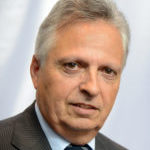
The role of water in the EU clean energy transition
Water ecosystems such as oceans, seas and rivers are rich spaces where a great diversity of human activities is concentrated.
They represent a natural link between different sectors of the economy: maritime and fluvial transport, agriculture and food industries, tourism and, last but not least, energy.
Water and energy are a central part of our everyday life; be it for cooking, heating our homes, agriculture or running our industries. They are vital for our health and wellbeing.
Water and energy mutually need each other. They are closely interlinked in every possible way.
Energy is needed for the whole water cycle from water treatment to water supply. At the same time, water is needed for energy production.
When it comes to water and conventional energy, the interlinkages are extremely strong. Fossil energy supplies, such as coal and LNG, are transported via the oceans or seas and through the rivers of Europe.
In addition, thermal power stations, including nuclear power plants, rely on water for cooling. During the summer of 2015, rivers in Poland had not enough water to cool down power plants.
Coal power plants had to reduce their electricity generation, raising concerns about energy security. This shows how important water is for energy access and energy security.
At the same time, water plays a key role in the clean energy transition.
Water ecosystems support the development of low-carbon solutions and shelter more and more innovative energy solutions such as storage, offshore wind and marine energies.
Water is central for the development of renewable energy.
In 2016, hydropower accounted for 11.7% of the overall electricity generation in Europe. In addition, pumped hydro storage contributes to the integration of renewable energy in the energy system by providing flexible back-up capacity and by playing an important role in balancing the grid.
Sources of flexibility such as these, that can react quickly, will become increasingly important as variable renewable electricity production increases.
Indeed, renewable energy represents already today over 30% of Europe electricity generation and by 2030, it is expected that more than half of the electricity in Europe will come from renewables.
As part of the Clean Energy for All Europeans Package, the Commission has put forward the most advanced regulatory framework to support the clean energy transition and deliver on its Paris Agreement commitments.
Interinstitutional negotiations are progressing well. Four of the eight proposals are already politically agreed covering in particular energy efficiency, renewable energies and the Energy Union Governance.
Negotiations are still ongoing for the remaining proposals on electricity market design which aims to make the electricity system fit for the future and able to integrate in a secure and cost-competitive way the growing share of variable renewable energies.
The revised Renewable Energy Directive sets an ambitious binding target at EU-level of at least 32% by 2030 in the EU’s final energy consumption.
It also puts forward measures to accelerate the development of renewables in the electricity sector but also in other sectors, such as heating and cooling and transport.
Traditional hydropower is not the only way in which water can play a role in the clean energy transition and in reaching our 2030 renewable energy target.
Oceans and seas can significantly contribute with strong and continuous generation. Indeed, they have a potential of supplying at least 100GW by 2050 in Europe, which would be enough to cover 10% of EU’s electricity demand.
Marine energy is a growth sector that can spur investment in new technologies such as offshore and floating wind, tidal streams, waves, algae and ocean thermal energy and thus provide EU companies with a competitive edge.
Due to strong research capabilities and maritime engineering experience, Europe is the clear global leader: 84% of the market for offshore wind is European. 50 % of the world’s tidal energy developers, 60 % of wave energy developers and 70 % of the ocean energy research and testing infrastructure are European.
As the EU is moving towards a low-carbon economy, water will play an increasing role and some clean technologies can have important water demand.
This is the case for biofuel production, concentrating solar power, carbon capture and storage and nuclear power plants. It is therefore important to find the right balance between water demand and the clean energy transition.
Today, bioenergy represents half of renewable energies consumed in Europe and their use will increase particularly in the heating and transport sectors.
In that context, the use of water but also the synergies with the agriculture sector should be carefully considered.
Agriculture is currently the largest user of water at global level. The revised Renewable Energy Directive has consolidated the sustainability framework in order to ensure a sustainable development of the bio-energy sector.
Overall, it is key that the clean energy transition closely takes into account the impact on water consumption and ensure proper management of water resources.
This is crucial at a time drinking water is becoming increasingly scarce. Synergies between water and energy policies but also with other sectors of the economy should be taken into account.
The success of Europe’s clean energy transition depends on it. In this context, the Commission will soon present its global vision for a long-term decarbonisation strategy in accordance with the Paris Agreement.
This strategy will be presented in November this year, ahead of the COP24 taking place in Katowice, Poland in December 2018.




